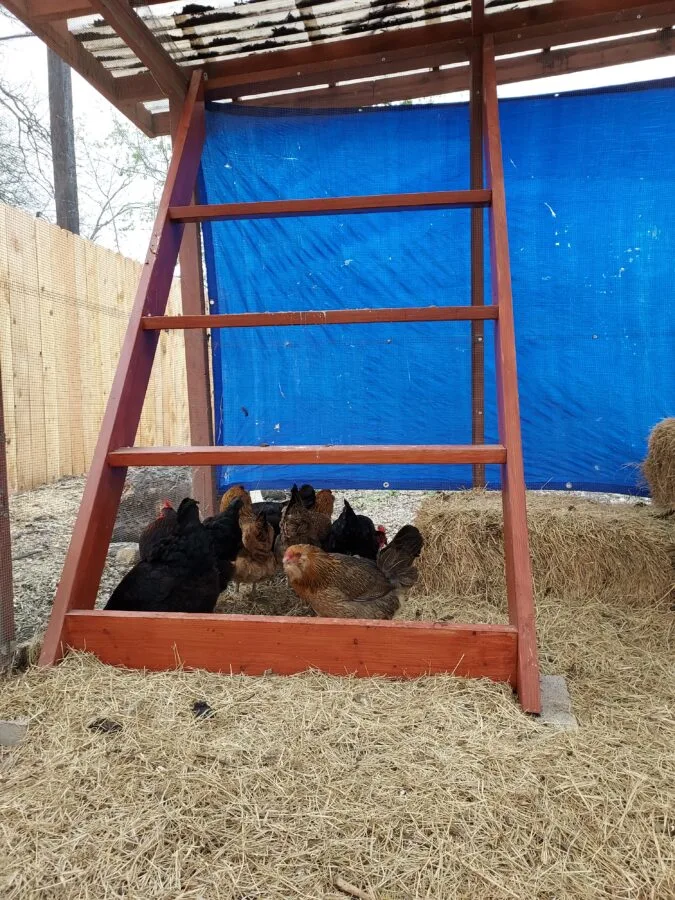Chicken roosts are a crucial part of the coop. Your flock relies on them to feel safe while sleeping, and they can help keep your coop clean. Here are the best sizes and styles for you to use!

When we made our hot weather chicken coop, I always intended to build a chicken roost that matched the outer wood and add it into the interior of the coop. Because life happens, I tossed some large branches and logs into the coop for the bantams to use until we got it done.
Sadly, our entire flock was killed before that day ever came. (You can read more about it on How To Cope With Loss On The Homestead).
Some friends who were moving offered us their flock, and with a newly replaced fence we happily said yes. The new birds are full size, and definitely needed a proper roost. My husband very sweetly built the roost I had envisioned from the beginning and the birds are happily sitting on it right now!
Chickens rely on their roosts at night to feel safe from predators. They instinctively seek out the highest point to bed down for the night. They also like to group together, and this helps them stay warm in cooler weather. If you don’t have a great roost for your coop, you need one!
What Size Chicken Roosts Do You Need?
Before we started building, I first needed to get measurements. Full size hens need 8-10 inches of space per bird on the roost. If there’s not enough space on the top roost hens lower in the pecking order will get bumped to a lower space. They’re happier if they all fit on the same level though, so try to go for longer if you can.
If there is any other surface in the coop higher than the roosts, they will use that, so make sure to plan it tall enough. Somewhere between 3-5 feet tall is good if you have a human-height coop. If your coop is short, make sure to leave about 18 inches between the roost and the roof so your birds have enough head space. And of course, they will need a way to reach that higher height, so steps or things to jump on are a good addition.
Some very flighty birds may just fly up there, but bantams, older hens, and heavy breeds should have steps no more than 18 inches apart. A very common style perch is made like a ladder. This is a good way to make sure all your birds can get up and down easily. This is the type of roost we made for our coop. You can see pictures I used for inspiration here, here, and here.
On a ladder style perch, steps should be about 12 inches apart in height. If you have small birds you can have them 12 inches apart in width as well. However, in many cases, 15-18 inches may be better. We went with 12 inches apart, but our large birds overhang the step a little so when they face backward they end up pooping on the lower step all night. Whoops!

(The tarp is up for wind protection during an unusually chilly week)
What Should I Make The Roosts Out Of?
The most common material for building your own roosts is wood. Plastic and metal can be slippery and hot and chickens like to feel like they’re resting solidly. You can use large branches or 2x4s with the wide side up. You want to give them plenty of space to grip. If your roosts are too thin you can cause pain and foot problems for your birds.
Chickens can get splinters that cause bumblefoot and pain, so don’t use super rough or splintery woods. Wood roosts can sometimes get mites, so make sure to keep your coop clean. A good blast with the hose has worked well for our roosts so far. Chickens do most of their pooping at night, so under your roosts is likely to get muckier than other areas of your coop.
And of course whatever you make needs to be solid so that it can hold the weight of your chickens! If you attach a bar to your coop walls make sure it’s well anchored. If you use tree branches examine them for any signs of cracking and make sure they’re thick enough to hold your flock’s weight.
Chicken roosts are not complicated, but they are a very important part of keeping your flock feeling safe, happy, and clean. If you haven’t added one to your coop, make sure to do it now!
Want To Raise Happy Chickens?
Subscribe for our newsletter and get the free email course Intro To Backyard Chickens as well as a free printable checklist to walk you through step by step!
